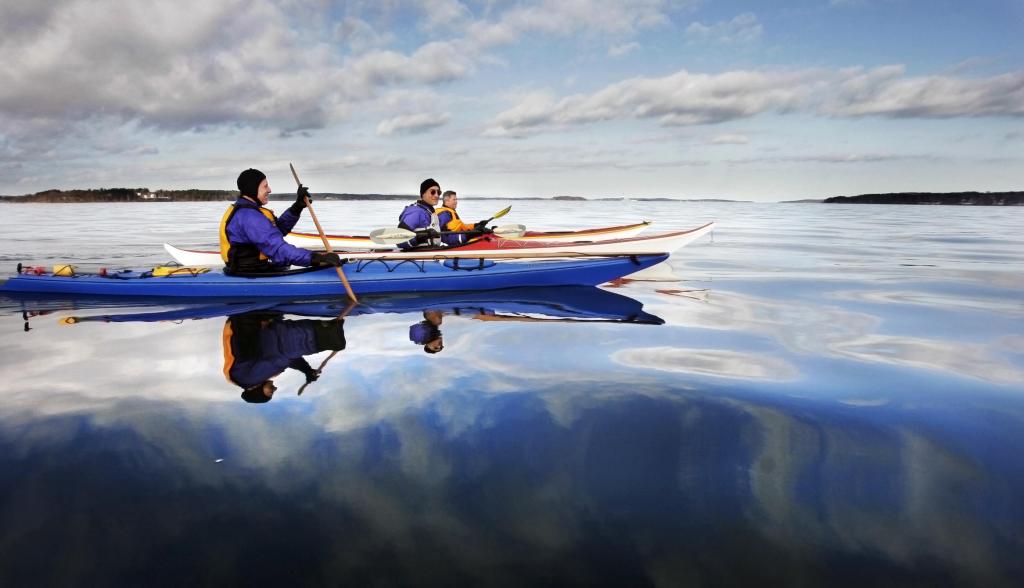Q: Why would you kayak in the winter?
A: It may help to be a little crazy. But Theresa Willette, a Registered Maine Sea Kayak Guide for more than eight years, says kayaking in the winter is a different animal. Literally.
”I go out because you see different wildlife in the winter,” says Theresa, who owns Coastal Maine Kayak in Kennebunk. ”I just saw an ice seal. You don’t get to see those in the summer.” The birds are different too.
Plus, there is less boat traffic to contend with.
If you’re going to do this, you need to be prepared and dress for a possible swim. Hey, it doesn’t matter how good you are. Theresa says she was out with some very experienced kayakers when one flipped his kayak. He knew how to roll back up, but couldn’t that day, and needed help.
So be prepared. ”The most important thing you can own in this environment is a drysuit,” she says. A drysuit is made of waterproof material that goes from your toes to your neck and wrists. Like the name says, it keeps you dry if you end up in the cold water.
Use neoprene gloves and a cap to help keep warm too.
Then you need layers underneath your drysuit to keep you warm. Theresa says fleece and wool are best. Remember, cotton kills at sea too. If the layers get wet, they will keep you warm.
Wait a minute. Isn’t that what a drysuit prevents from happening?
Yes, in a perfect world. But if everything is perfect and accidents don’t happen, you wouldn’t end up falling into the water. So be prepared.
Besides, the water may come from an internal source — sweat. This depends on the paddler’s metabolism. But those wicking layers will help send the moisture from the skin. And if the drysuit is made with Gore-Tex or a breathable substitute, it will allow internal moisture to evaporate.
Next on the needed list would be a VHF two-way radio to call for help. Carry flares too. They may attract attention faster than a mayday call.
Also, a float plan is needed. Give it to friends or someone responsible in case you don’t check in. Then they know where to send rescuers.
While you’re at it, don’t forget the safety equipment you would carry in the summer: spare paddle, pump, paddle float.
In your kayak, stash some supplies to warm you up in case you do go over. Hand warmers will go a long way.
Theresa likes the Jetboil PCS stoves. These compact camping stoves will fit into dry hatches nicely and quickly heat a liter of liquid. A warm drink can make a world of difference to a wet paddler in the winter.
Pack a change of clothes in a dry bag. Again, you’re preparing for the worst.
If you’re going to take a cell phone, store it in a dry box. That will keep the water out and it will float if dropped.
Probably the most important safety gear to take is a buddy or two. ”I would not go out by myself,” Theresa says. And she has been paddling more than 30 years. ”I know a lot of very experienced people who gather a group. Things can happen to anybody.”
So once you’re prepared, where are the best places? Theresa likes to stick close to shore for two reasons. First, it’s a good place to see the wildlife. (She does enjoy paddling out to French Island to see the seals. Of course, she keeps her distance so not to disturb them.)
Second, she doesn’t venture too far out for safety reasons.
Theresa also wants to warn paddlers about ice. Water flows under the ice. If you paddle up to the ice, a strong current can grab your boat and drag it — and you — under.
Yes, kayaking on the ocean takes care. But it can be done safely. The reward for the risk is a beautiful experience you can’t have in the summer.
Carl Natale is a Registered Maine Sea Kayak Guide, hiker and content producer for MaineOutdoorJournal.com. Send questions to: cvn@mainetoday.com
Send questions/comments to the editors.


